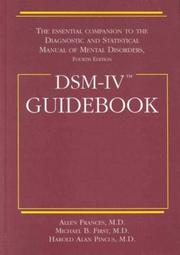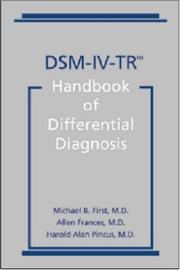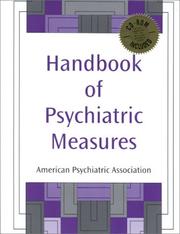| Listing 1 - 10 of 14 | << page >> |
Sort by
|
Book
Year: 2005 Publisher: Santa Monica, CA : RAND Corporation,
Abstract | Keywords | Export | Availability | Bookmark
 Loading...
Loading...Choose an application
- Reference Manager
- EndNote
- RefWorks (Direct export to RefWorks)
Community leaders in the Pittsburgh region have long recognized the critical importance of the health and well-being of mothers, infants, and young children and have made intensive efforts to develop effective community-based early childhood interventions and support services. Despite these efforts, in several key areas, mothers and young children in this community are not receiving the health care services they need, and the result is premature illness and preventable death. In 2002, The Heinz Endowments commissioned the RAND Corporation and the University of Pittsburgh, in partnership with the Department of Health and Department of Human Services in Allegheny County, Pennsylvania, to establish a learning collaborative of local stakeholders to (1) catalyze new thinking around the best evidence and practice for maternal and child health care; (2) assess the strengths, weaknesses, and barriers to improvement in the current system; (3) identify targets for local policy reform; and (4) develop a blueprint for action. This report provides an overview of the community-based approach through which this work was undertaken, highlights key study findings, and outlines a vision, strategy, and action plan for achieving systemwide improvements in maternal and child health care processes and outcomes.

ISBN: 0880484306 0880484152 9780880484152 9780880484305 0880484314 9780880484312 Year: 1995 Publisher: Washington, DC : American Psychiatric Press,
Abstract | Keywords | Export | Availability | Bookmark
 Loading...
Loading...Choose an application
- Reference Manager
- EndNote
- RefWorks (Direct export to RefWorks)
Mental disorders, diagnosis, case studies. --- Mental disorders, therapy, case studies. --- Mental disorders --- Mental illness --- Classification. --- Diagnosis. --- Classificatie. --- Diagnosis, Differential. --- Diagnostic and statistical manual. --- Diagnostiek. --- Mental Disorders --- Mental illness. --- Psychische stoornissen. --- Diagnostic and statistical manual of mental disorders --- Diagnostic and statistical manual of mental disorders.

ISBN: 1585620548 1585622656 1585624624 1585629987 1585629995 Year: 2014 Publisher: Washington, DC American Psychiatric Publishing, a division of American Psychiatric Association
Abstract | Keywords | Export | Availability | Bookmark
 Loading...
Loading...Choose an application
- Reference Manager
- EndNote
- RefWorks (Direct export to RefWorks)

ISBN: 2225833214 Year: 2005 Publisher: Paris Masson
Abstract | Keywords | Export | Availability | Bookmark
 Loading...
Loading...Choose an application
- Reference Manager
- EndNote
- RefWorks (Direct export to RefWorks)

ISBN: 0890420564 Year: 1998 Publisher: Washington American psychiatric association
Abstract | Keywords | Export | Availability | Bookmark
 Loading...
Loading...Choose an application
- Reference Manager
- EndNote
- RefWorks (Direct export to RefWorks)

ISBN: 0890424152 Year: 2000 Publisher: Washington (D.C.) American Psychiatric Association
Abstract | Keywords | Export | Availability | Bookmark
 Loading...
Loading...Choose an application
- Reference Manager
- EndNote
- RefWorks (Direct export to RefWorks)
#PBIB:2003.3 --- Mental illness --- Psychiatric rating scales --- Psychiatric Status Rating Scales --- Mental Disorders --- Diagnosis --- diagnosis --- Mental disorders --- Psychiatric status rating scales --- Rating scales, Psychiatric --- Scales, Psychiatric rating --- Scales, Rating (Psychiatry) --- Psychodiagnostics --- Treatment --- Evaluation
Book
Year: 2001
Abstract | Keywords | Export | Availability | Bookmark
 Loading...
Loading...Choose an application
- Reference Manager
- EndNote
- RefWorks (Direct export to RefWorks)
Alcoholism --- Evidence-based medicine. --- Primary health care. --- Evidence-Based Medicine. --- Primary Health Care. --- Diagnosis. --- Treatment. --- diagnosis. --- therapy.
Book
Year: 2019 Publisher: Santa Monica, Calif. RAND Corporation
Abstract | Keywords | Export | Availability | Bookmark
 Loading...
Loading...Choose an application
- Reference Manager
- EndNote
- RefWorks (Direct export to RefWorks)
Since as far back as World War II, behavioral health technicians (BHTs) have been used to increase the capacity of the military behavioral health workforce and ensure that service members who need behavioral health care have access to high-quality, efficient services. The demands that BHTs face have undoubtedly evolved alongside the changing needs of the military, but it is unclear whether this valuable component of the Military Health System (MHS) mental health care workforce is adequately prepared to fulfill these roles or whether the MHS is making the best use of BHTs' skills. This report provides preliminary insights on selection, training, roles, and responsibilities. Though BHT training is based on the expected roles and responsibilities of BHTs, there may be opportunities to better align the curriculum with the demands of BHTs in the field and the needs of the population they serve. In addition, findings suggest that BHTs may not consistently have the opportunity to apply the full extent of their clinical training, and there is a need to better understand how factors such as setting, supervisor preferences, and availability of ongoing training affect their roles. The recommendations presented provide preliminary suggestions on ways to optimize the training and roles of BHTs in the field, with the goal of ensuring that the MHS can continue meeting the need for high-quality mental health care among service members and their families.
Book

Year: 2021 Publisher: Santa Monica, Calif. RAND Corporation
Abstract | Keywords | Export | Availability | Bookmark
 Loading...
Loading...Choose an application
- Reference Manager
- EndNote
- RefWorks (Direct export to RefWorks)
Behavioral health (BH) conditions—such as posttraumatic stress disorder, depression, and anxiety—are the second most common medical reasons for nondeployability in the U.S. Army. The authors of this report aimed to identify promising metrics to assess readiness among soldiers and adult family members who receive BH care. These metrics would expand the Army's outcome monitoring, which currently includes symptom improvement metrics, for patients who received BH care. The authors developed rigorous criteria to evaluate candidate readiness metrics, conducted interviews with stakeholders (Army subject-matter experts and BH providers), reviewed existing sources of data that could support the development of a readiness metric, and conducted a literature review to identify instruments that have been used to measure readiness-related domains in both military and civilian populations. The authors found that no existing data source or patient self-report instrument met criteria for implementation of a readiness metric for soldiers, but one instrument, the Walter Reed Functional Impairment Scale (WRFIS), is promising. No existing data source or patient self-report instrument met criteria for Army-wide implementation of a readiness metric for adult family members. Stakeholders reported that psychiatric symptoms, diagnosis, treatment, and impaired functioning are important indicators of lack of readiness among soldiers and adult family members. BH providers reported variability in assessing readiness and applying profiles, but behavioral experts provided suggestions for improving readiness assessment. The authors recommend that the Army conduct a pilot evaluation of a soldier readiness metric based on the WRFIS and increase standardization in applying profiles by continuing provider training.
Families of military personnel --- Soldiers --- Services for --- Evaluation. --- Mental health --- United States
Book

Year: 2021 Publisher: Santa Monica, Calif. RAND Corporation
Abstract | Keywords | Export | Availability | Bookmark
 Loading...
Loading...Choose an application
- Reference Manager
- EndNote
- RefWorks (Direct export to RefWorks)
The Military Health System (MHS) aims to improve the health of all U.S. military personnel, provide the highest quality of care possible, maintain low per capita health care costs, and support overall military readiness. High-quality, evidence-based behavioral health treatment is central to individual well-being and the overall health of the force. However, there has been little research to date on the behavioral health care that National Guard and reserve personnel—collectively known as the reserve component (RC)—receive from the MHS. The full-time personnel in the U.S. military's active component (AC) overwhelmingly receive behavioral health care in military treatment facilities and generally from behavioral health specialty providers, RC personnel rely much more heavily on private-sector contracted care (also referred to as purchased care) and primary care providers. MHS administrative data indicate that RC personnel are less likely to receive recommended treatment for PTSD, depression, and substance use disorders. Likewise, RC personnel who live in areas that are remote from a military treatment facility are less likely than who do not to receive recommended treatment for these conditions. These findings, which focus on behavioral health care access and quality, highlight pathways to improvement for the MHS as part of its ongoing transition to a more centralized model for delivering and overseeing health care across the force.
| Listing 1 - 10 of 14 | << page >> |
Sort by
|

 Search
Search Feedback
Feedback About UniCat
About UniCat  Help
Help News
News